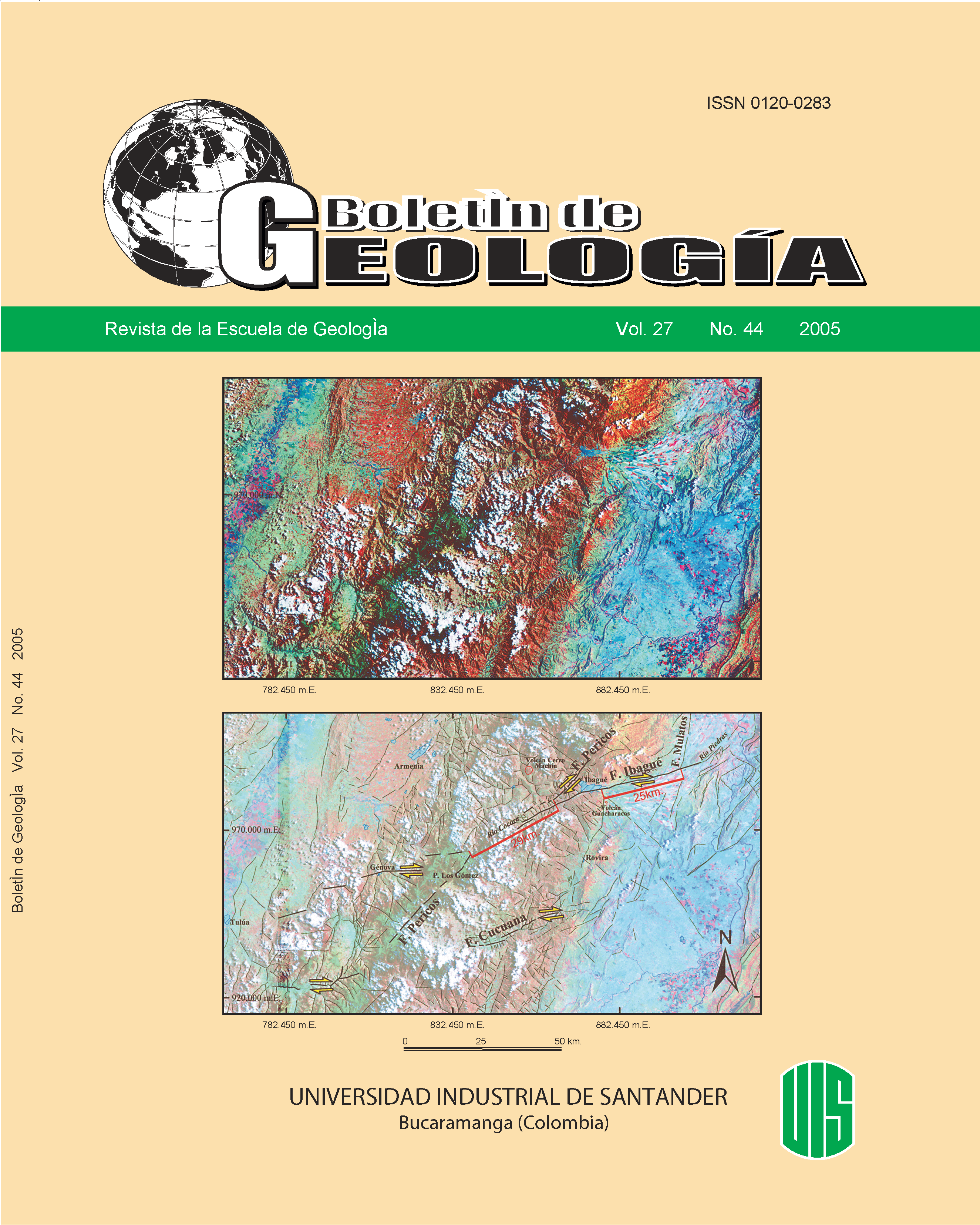Morphotectonic interpretation of the Ibague fault for paleoseismological purposes
Published 2005-01-11
Keywords
- Neotectonics,
- Wrenching,
- Ibagué Fault,
- Colombia
How to Cite
Abstract
The Ibagué Fault is a WSW-ENE right-lateral strike-slip structure located in the central part of the Central Cordillera and in the middle of transverse shear zone that affects the Colombian Andes. Morphotectonic interpretations of the fault from satellite images allow us to propose the style of deformation and the kinematics of the structure. These structural characteristics together with geographical, geomorphologic, sedimentologic and climatic data are key elements for the right selection of a paleoseismical investigation site. The strand appears to be as a single line along the Ibagué Fan at regional scale. However, detailed studies shown several morphotectonic features characteristic of wrench tectonics. Riedel and en-echelon array indicate dextral displacements. Additionally, microtectonic data show a local stress tensor with a s1=311º/18 °±15 ° and a factor R=0,62, indicating a strike-slip regime, which is coherent with the observed geologic and morphotectonic features.
Downloads
References
Angelier, J., Mechler, P. (1977). Sur une méthode graphiquede recherche des contraintes principales égalementutilisable en tectonique et enséismologie: la methode desdiédres droits. – Bull. Soc. Géol. France, Paris, Vol. VII,19, pp. 1309-1318
Arcila, M., Muñoz, A., De Vicente, G. (2002). Análisissismotectónico de la convergencia Caribe, Nazca ySuramérica. Primer simposio colombiano de sismología.Ingeominas, Bogotá.
Audemard, F. A., (1993). Néotectonique, Sismotectoniqueet Aléa Sismique du Nord-ouest du Vénézuéla (systèmede failles d’Oca-Ancón). Thèse Doctorat UniversitéMontpellier II. Inédito, 369 p
Audemard, F. A., (1998). Evolution Géodynamique de laFaçade Nord Sud-américaine: Nouveaux apports del’Histoire Géologique du Bassin de Falcón, Vénézuéla. XIVCaribbean Geological Conference, Port of Spain,Trinidad, 1995. Vol. 2, pp. 327-340.
Audemard, F. A., (2003). Geomorphic and geologicevidence of ongoing uplift and deformation in the MéridaAndes, Venezuela. Quaternary International 101-102C, pp.43-65
Audemard, F. A., (2004). Paleoseismology in Venezuela:objectives, methods, applications, limitations andperspectives. Tectonophysics (in press).Audemard, F. E., Audemard, F. A. (2002). Structure ofthe Mérida Andes, Venezuela: relations with the SouthAmerica-Caribbean geodynamic interaction.Tectonophysics, Vol. 345(1-4), pp. 299-327
Audemard, F. A., Singer, A. (1996). Active FaultRecognition in Northwestern Venezuela and itsSeismogenic Characterization: Neotectonic andPaleoseismic approach. In: Enghdal, E.R., Castano, J. &Berrocal, J. (eds.), Proceedings of the 1994 RegionalSeismological Assembly in South America. GeofísicaInternacional; México, Vol. 35(3), pp. 245-255.
Audemard, F. A., Singer, A. (1994). Parámetrossismotectónicos para fines de evaluación de la amenazasísmica en el noroccidente de Venezuela. VII CongresoVenezolano de Geofísica, pp. 51-56.Diederix, H., Gómez, H., Khobzi, J., Singer, A. (1987).Indicios neotectónicos de la Falla de Ibagué en el sectorIbagué-Piedras, departamento del Tolima, Colombia.Revista CIAF, Bogotá, Vol. 11 (1-3), pp. 242-252
Funvisis. (1997). Evaluación preliminar del sismo deCariaco del 9 de Julio de 1997, Estado de Sucre, Venezuela.Harding, T. P. (1974). Petroleum traps associated withwrench faults. AAPG Bull. Vol. 58-7, pp. 1290-1304
Ingeominas. (1997). Atlas Geológico digital de Colombia(versión 1). Escala 1:500.000
Lobo-Guerrero, A. (1974). Notas sobre la Falla de Ibagué,Ingeominas, Ibagué (informe interno).
